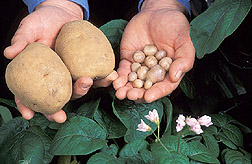Washington, DC
November 20, 2007
ARS News Service
Agricultural Research Service, USDA
By Ann
Perry
 "One
potato, two potato, three potato, four" turns out to be exactly
right—when classifying cultivated potatoes, that is. Scientists
at the Agricultural Research Service (ARS)
and the International Potato Center (CIP)
have used morphology—the outward appearance of a plant- -in
combination with molecular markers to revise the number of
potato species from seven to four. "One
potato, two potato, three potato, four" turns out to be exactly
right—when classifying cultivated potatoes, that is. Scientists
at the Agricultural Research Service (ARS)
and the International Potato Center (CIP)
have used morphology—the outward appearance of a plant- -in
combination with molecular markers to revise the number of
potato species from seven to four.
Until recently, potato species
designations have been based primarily on morphological
characteristics and estimates—often incorrect—of how many
chromosome sets they possessed.
Botanist
David Spooner works in the
ARS Vegetable Crops Research Unit, Madison, Wis. His initial
research with CIP colleagues in Peru indicated that
morphological variations among cultivated potatoes were not
reliable indicators of species.
They then examined DNA
molecular markers from 742 cultivated potato varieties and eight
wild relatives of potatoes. Based on results from this study and
previous studies, Spooner and CIP lead scientist Marc Ghislain
concluded that cultivated potato varieties could most accurately
be assigned to one of four species.
They refined the species
designations by checking each potato variety for the presence of
one particular DNA mutation. This characteristic mutation
distinguishes between potatoes from the Chilean lowlands and
potatoes from the high Andes.
Solanum tuberosum—the
type of domesticated potato eaten around the world—is one of the
four recognized species. This is by far the most common potato
species and has from two to four sets of chromosomes.
The less common potato species—S.
ajanhuiri, S. juzepczukii and S. curtilobum—have
two, three and five sets of chromosomes, respectively. These can
often be distinguished from each other by morphological data.
This new system of species
classification eliminates much of the guesswork that previously
served as the foundation for the potato classification system.
Potato breeders will benefit greatly from a classification
system that groups related collections by combining traditional
morphological with modern molecular methods.
A paper reporting the results
of this study was published this week in the
Proceedings of the National
Academy of Sciences of the United States of America.
ARS is the
U.S. Department of Agriculture's
chief scientific research agency.
Los científicos del Servicio de
Investigación Agrícola (ARS)
y del Centro Internacional de la Papa (CIP
por sus siglas en inglés) han usado la morfología -- el aspecto
exterior de una planta -- en combinación con marcadores
moleculares para reducir de siete a cuatro el número de especies
de papa.
Hasta recientemente, las
designaciones de las especies de papa han sido basadas
primariamente en características morfológicas y estimaciones --
a menudo incorrectas - - del número de pares de cromosomas en
esas especies.
El botánico
David Spooner trabaja en la
Unidad de Investigación de Cosechas Vegetales mantenida por
ARS en Madison, Wisconsin. Su investigación inicial en
colaboración con colegas del CIP en Perú indicó que las
variaciones morfológicas entre las papas cultivadas no son
indicadores confiables de la identidad de las especies.
Los investigadores luego
examinaron los marcadores moleculares del ADN de 742 variedades
cultivadas de papas y ocho parientes silvestres de papa. Como
resultado de los hallazgos de este estudio y estudios previos,
Spooner y el científico principal del CIP Marc Ghislain llegaron
a la conclusión de que las variedades cultivadas de papa podrían
ser más precisamente clasificadas como solamente cuatro
especies.
Ellos refinaron las
designaciones de las especies examinando cada variedad de papa
para la presencia de una mutación particular de ADN. Usando esta
mutación característica como un indicador clave, es posible
distinguir entre las papas de las tierras bajas de Chile y las
papas de los Altos Andes.
Solanum tuberosum -- la
especie de papa domesticada consumida en todas partes del mundo
-- es la más común y tiene de dos a cuatro pares de cromosomas.
Las tres especies de papa menos
comunes -- S. ajanhuiri, S. juzepczukii y S.
curtilobum -- tienen dos, tres y cinco pares de cromosomas,
respectivamente. A menudo se puede distinguir entre estas
especies mediante los datos morfológicos.
Este nuevo sistema de
clasificar especies elimina muchas de las conjeturas que
previamente eran la base del sistema de clasificación de la
papa. Los criadores de papa se beneficiarán de un sistema de
clasificación que agrupa colecciones relacionadas combinando
métodos morfológicos tradicionales con métodos moleculares
modernos.
Un artículo sobre los hallazgos
de este estudio fue publicado esta semana en 'Proceedings
of the National Academy of Sciences of the United States of
America' (Procedimientos de la Academia Nacional de Ciencias
de EE.UU.)
ARS es la agencia principal
de investigaciones científicas del
Departamento de Agricultura de
EE.UU. |